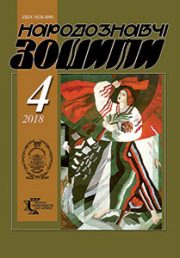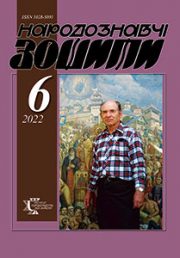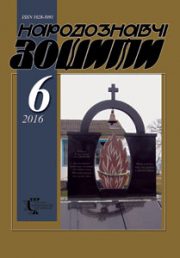The Ethnology Notebooks. 2020. № 1 (151), 3—14
UDK[7:39:008]:351.854(477)]:061.1(=1:100)”19/20″
DOI https://doi.org/10.15407/nz2020.01.003
PRESERVATION OF THE INTANGIBLE CULTURAL HERITAGE: UKRAINIAN EXPERIENCE
HERUS Lyudmyla
ORCID ID: https://orcid.org/0000-0002-5931-3816
Сandidate of Аrts (Ph. D), Senior Researcher
of the Institute of Ethnology of the National Academy
of Sciences of Ukraine,
in the Department of Folk Art,
15, Svobody Avenue, 79000, Lviv, Ukraine,
Contacts: e-mail: ludmilagerus@gmail.com
Abstract. Introduction. At the end of XX — early XXI centuries globalization, social transformations and the continuous development of information and communication technologies have gained particular intensity, have become a source of enormous threat to the destruction and disappearance of the traditional culture and deepened the actuality of preservation and safeguarding the humanity cultural heritage. The European choice of Ukraine, its integration into the international community strengthen the state responsibility for the preservation of original historical relics of different times and peoples that are on its territory and are an integral part of the world cultural heritage.
Article purpose: comprehensive analysis of the formation, current state and prospects of safeguarding the intangible cultural heritage in Ukraine.
Methods. The basic in the research is a systematic approach, which provides an analysis of UNESCO’s activity as a component of the United Nations Institutional system, its relations with other specialized institutions in the field of the intangible cultural heritage safeguarding, adaptation the protecting of the intangible cultural heritage in Ukraine to UNESCO normative principles, reached results and perspective ways of implementation. The statistical method was applied to assess the consequences of the measures taken in Ukraine to the intangible cultural heritage safeguarding.
Results. International conventions, acts adopted by UNESCO specialized agencies of the intangible cultural heritage safeguarding, regulatory acts of Ukrainian legislation are considered in the article. The strategy and directions of protection the elements of the intangible cultural heritage in Ukraine are analyzed as a result of the state authorities activity, specialized institutions and the public in the context of the basic principles of international cultural policy.
In the article the next conclusions are drawn. There are the necessity to coordinate the activities of public authorities and local self-government, academics, the public in order to preservation, develop and promote the intangible cultural heritage of Ukraine; adopting the National Target Program for the Safeguarding of the Intangible Cultural Heritage and based on it regional programs containing conceptual provisions and practical measures of the intangible cultural practices preservation, in particular the development of humanitarian education, the formation a wide range of information sources and popularization activities, the use of scientific potential specialists.
Keywords: intangible cultural heritage, preservation, safeguarding, popularization, artefacts, Ukraine, UNESCO.
Received 26.01.2020
REFERENCES
Andres, H.A. (2008). Safeguarding of Ukraine’s cultural heritage in the context of European integration. Problems and solutions. Sugdeian Collection (Issue ІІІ, pp. 524—533) [in Ukrainian].
Bosyk, Z.A. (2015). Intangible cultural heritage of Ukraine in the context of social development and cultural policy of the state. Bulletin of the National Academy of the commanding personnel of culture and art, 2, 35—39 [in Ukrainian].
Dontsov, A. (2018). Establishment of students’ creative personality in tourism profession through individual and group teaching. Problems of continuous geographical education and cartography (Issue 28, pp. 4—10) [in Ukrainian].
Kuderska, N.I., & Kuderska, I.O. (2015). Intangible cultural heritage of Ukraine, its objects (manifestations). European perspectives (Issue 7, pp. 59—67) [in Ukrainian].
Melnychuk, О.І. (2003). Intangible cultural heritage concept. Formation in international law. Monuments of Ukraine: history and culture, 3, 12—17) [in Ukrainian].
Polyvach, K.A. (2012). Cultural heritage and its influence on the development of regions of Ukraine. Kyiv: Instytut geografii NAN Ukrayiny [in Ukrainian].
Теrеs, N. (2011). International safeguarding of the intangible cultural heritage: world and Ukrainian experience. Ethnic history of the peoples of Europe (Issue 36, pp. 58—63) [in Ukrainian].
Recommendation on the Safeguarding of Traditional Culture and Folklore. Retrieved from: https://etnoua.info/novyny/rekomendacija-oon-pro-zberezhennja-folkloru/ (Last accessed: 21.01.2020).
Report on the preliminary study on the advisability of regulating internationally, through a new standard-setting instrument, the protection of traditional culture and folklore. Retrieved from: https://unesdoc.unesco.org/ark:/48223/pf0000122585 (Last accessed: 21.01.2020).
UNESCO UNIVERSAL DECLARATION ON CULTURAL DIVERSITY. Retrieved from: http://www.unesco.org/new/fileadmin/MULTIMEDIA/HQ/CLT/pdf/5_Cultural_Diversity_EN.pdf (Last accessed: 21.01.2020).
Convention for the Safeguarding of the Intangible Cultural Heritage. Retrieved from: https://zakon.rada.gov.ua/laws/show/995_d69.
Convention on the Protection and Promotion of the Diversity of Cultural Expressions. Retrieved from: https://zakon.rada.gov.ua/laws/show/952_008 / (Last accessed: 21.01.2020).
Convention for the Protection of the World Cultural and Natural Heritage. Retrieved from: https://unesdoc.unesco.org/ark:/48223/pf0000218120 (Last accessed: 21.01.2020).
Browse the Lists of Intangible Cultural Heritage and the Register of good safeguarding practices. Retrieved from: https://ich.unesco.org/en/lists#2019 (Last accessed: 21.01.2020).
Ministry of Culture presents the bill «On Intangible Cultural Heritage». Retrieved from: https://www.kmu.gov.ua/news/248077113. (Last accessed: 21.01.2020).
All-Ukrainian open competition of programs for preservation and development of elements of intangible cultural heritage «Living tradition». Retrieved from: http://uccs.org.ua/featured/vseukrainskyj-vidkrytyj-konkurs-prohram-zberezhennia-i-rozvytku-elementiv-nematerialnoi-kulturnoi-spadshchyny-zhyva-tradytsiia/ (Last accessed: 21.01.2020).
The UCCR annual report on the state of implementation in Ukraine of the provisions of the UNESCO Convention on the Safeguarding of the Intangible Cultural Heritage. 2018. Retrieved from: http://uccs.org.ua/wp-content/uploads/2019/01/zvit-2018_-unesco.pdf. (Last accessed: 21.01.2020).
Virtual Museum of the Intangible Cultural Heritage of Ukraine. Retrieved from: http://virtmuseum.uccs.org.ua/ua (Last accessed: 21.01.2020).
National list of elements of the Intangible Cultural Heritage of Ukraine. Retrieved from: https://www.docdroid.net/Ze1KwjQ/natsionalniy-perelik-elementiv-nksrishennya.doc#page=10 (Last accessed: 21.01.2020).
20 Intangible Cultural Heritage of Ukraine. Methodical development. Retrieved from: http://uccs.org.ua/wp-content/uploads/bsk-pdf-manager/2018-08-17_2.pdf (Last accessed: 21.01.2020).
Creativity based on intangible cultural heritage is the engine of development that meets the challenges of today — Yevhen Nishchuk. Retrieved from: https://www.kmu.gov.ua/news/kreativnist-zasnovana-na-nematerialnij-kulturnij-spadshchini-ye-dvigunom-rozvitku-yakij-vidpovidaye-viklikam-suchasnosti-yevgen-nishchuk (Last accessed: 21.01.2020).
On Parliamentary Hearing Recommendations: «State, problems and prospects of cultural heritage Safeguarding in Ukraine». Retrieved from: https://zakon.rada.gov.ua/laws/show/2716-19 (Last accessed: 21.01.2020).
Pavliuk, S., Herus, L., Fedorchuk, O., & Kutsyr, T. (3 eds.). (2019). Tradition Culture of Ukrainians in Researches by Folk Art Department of the Ethnology Institute of the National Academy of Sciences of Ukraine (1992—2018): Bibliography. The project scientifc supervisor S. Pavliuk; editor-in-chief L. Herus; edited and compiled by O. Fedorchuk; English translation of the Introduction by T. Kutsyr. Lviv: the Ethnology Institute of the NAS of Ukraine [in Ukrainian + Introduction).







